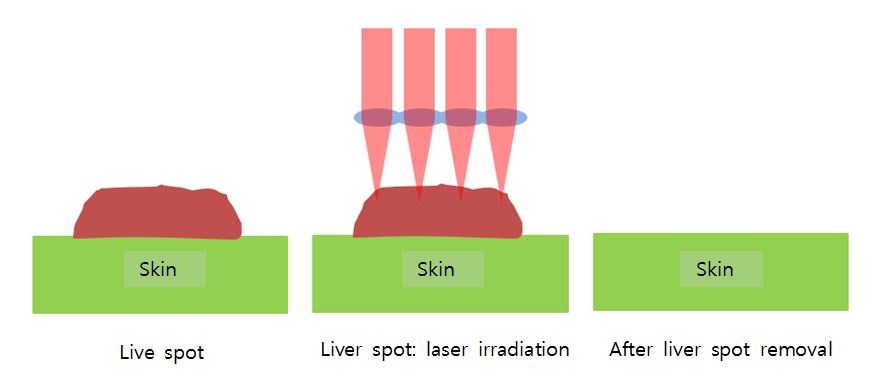
▶ Previous Artlcle: #7-2. CO2 Laser
The CO2 laser devices are very small and lightweight but have various CO2 laser beam generation methods in terms of machine structure. The method initially used for medical purposes is 'sealed tube CO2 laser' which uses high-voltage electrical discharge pumping to produce a laser.
However, this high-voltage electrical discharge provides a difficulty in uniform discharge within the medium. In recent years, 'RF excited waveguide CO2 laser' has began to be used as an advanced version. It produces a thin laser beam with a stable high output power, compared to sealed tube CO2 laser, which reduces incidence of post-procedural side effects and ensures a safe outcome for patients. In addition, its machine is so robust, durable, and lightweight, and easy to manage that it can be used with ease even at clinics.
figure 1. Liver spot removing procedure.
High and Low Outputs of CO2 Laser
As we know, CO2 laser is the one that uses CO2 gas as a medium. However, if a laser beam is generated by CO2 gas alone, output power becomes very low. Therefore, gas mixture of CO2, He, and N2 is used to produce a high-power laser beam. Xe may be added to the mixed gas to more greatly improve the laser function.
CO2 laser handpieces are divided into F-50 and F-100. F-50 is a handpiece with 50mm in focal length, and F-100 is a handpiece with 100mm in focal length. To be specific, an oscillated laser beam forms a focal point at a distance of 50mm and 100mm as it passes through the convex lens, resulting in a laser beam of high energy.
.jpg)
[Advertisement] FCR® (Fractional Prickle CoralCalcium Regentron) – Manufacturer: (www.illglobal.com)]
Therefore, when CO2 laser is used in clinical settings, procedure methods may differ in a variety of ways, depending on whether the procedure is focused or defocused.
The focusing technique refers to moving the handpiece towards the focal point to generate maximum output power, and the defocusing technique is to move the hendpiece away from the skin area to generate low output power. The focusing technique is mainly used to resect or vaporize a tissue, and the defocusing technique is useful for hemostasis of serious bleeding during tissue resection.
-To be continued




















